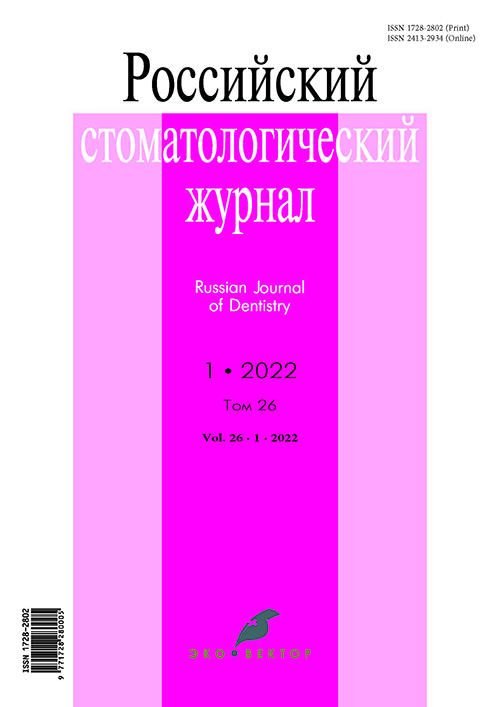Structural changes in masticatory apparatus organs and tissues with chronic environmental pathogenic factor exposure of flight labor
- Authors: Iordanishvili A.K.1,2
-
Affiliations:
- International Academy of Sciences of Ecology, Human Security and Nature
- Military Medical Academy named after S.M. Kirov
- Issue: Vol 26, No 1 (2022)
- Pages: 31-40
- Section: Clinical Investigations
- Submitted: 31.08.2022
- Accepted: 31.08.2022
- Published: 31.08.2022
- URL: https://rjdentistry.com/1728-2802/article/view/110722
- DOI: https://doi.org/10.17816/1728-2802-2022-26-1-31-40
- ID: 110722
Cite item
Abstract
BACKGROUND: The professional activity of the flight crew, conducted day after day under the constant influence of several unfavorable factors (hypergravity, vibration, altered barometric pressure, noise, etc.), leads to a significantly decreased quality of health and the development of phenomena of activity dysregulation of several organs and body systems, which manifests itself even in relative rest conditions.
AIM: To study the structural changes in masticatory apparatus organs and tissues under the influence of the main ecopathogenic factors of aviation labor on the body, such as chronic noise exposure, oxygen deficiency, barometric pressure changes, vibration, and hypergravity.
MATERIAL AND METHODS: The experimental study included 65 white male rats of the Wistar line, aged 8–34 weeks. Of these, 10 animals remained intact and 15 were subjected to chronic gravitational overloads following the generally accepted method. The remaining 40 animals were subjected to long-term isolated broadband noise exposure with an intensity of 100 dB, hypoxia, barometric pressure changes, and vibration following the generally accepted methods for modeling aviation overloads. At the end of the experiment, the animals were taken out of the experiment, and the material was taken for morphological studies.
RESULTS: The extreme factors of aviation flight (noise, hypoxia, barometric pressure drops, vibration, and hyperweight) with prolonged exposure to a living organism lead to the same type and non-specific multifunctional changes in the masticatory apparatus organs and tissues. The severity of these transformations is most clearly manifested in the hemomicrocirculatory bed and nervous structures and depends both on the air flight influencing factor type and on tissue sensitivity to the effects of these extreme factors.
CONCLUSIONS: The most unfavorable factor of flight labor is chronic gravitational overloads, and the salivary glands, masticatory muscles, and dental pulp are the most sensitive to this factor from the masticatory apparatus tissues.
Full Text
About the authors
Andrey K. Iordanishvili
International Academy of Sciences of Ecology, Human Security and Nature; Military Medical Academy named after S.M. Kirov
Author for correspondence.
Email: professoraki@mail.ru
ORCID iD: 0000-0003-0052-3277
MD, Dr. Sci. (Med.), Professor
Russian Federation, Saint Petersburg; Saint PetersburgReferences
- Trishkin DV. Medical support of the Armed Forces of the Russian Federation: results and goals for 2018. Military medical journal. 2018;339(1):4–16. (In Russ).
- Blaginin AA, Grebenyuk AN, Lizogub IN. The main ways of improvemnt of medical support of the air forces in modern conditions. Military medical journal. 2014;335(2):42–45. (In Russ).
- Ponomarenko VA, Vorona AA. Suppositions for development of preventive military air medicine. Military medical journal. 2014;335(10):55–59. (In Russ).
- Iordanishvili AK. Stomatologicheskie zabolevanija u letnogo sostava. Saint Petersburg: Riv’era; 1996. (In Russ).
- Pashhenko PS. Reguljatornye sistemy organizma v uslovijah gravitacionnogo stressa (morfofunkcional’nyj aspekt). Saint Petersburg: Krasnyj svet; 2007. (In Russ).
- Gajvoronskij IV, Kurochkin VA, Gajvoronskaja VV, et al. Zhevatel’nye myshcy: morfofunkcional’naja harakteristika i vozrastnye osobennosti v norme i pri vozdejstvii jekstremal’nyh faktorov. Saint Petersburg: Nordmedizdat; 2011. (In Russ).
- Gajvoronskij IV, Lobejko VV, Gajvoronskaja VV, et al. Okoloushnaja zheleza: morfofunkcional’naja harakteristika v norme i pri vozdejstvii jekstremal’nyh faktorov. Saint Petersburg: Nordmedizdat; 2011. (In Russ).
- Bondarev JV, Egorov VA, Novikov VS, Lustin SI. Medicinskoe obespechenie poletov na vertoletah nazemnogo i palubnogo bazirovanija. Saint Petersburg: VMedA; 1995. (In Russ).
- Kuprijanov VV. Puti mikrocirkuljacii. Kishinev: Kartja Moldovenjaskje; 1969. (In Russ).
Supplementary files















